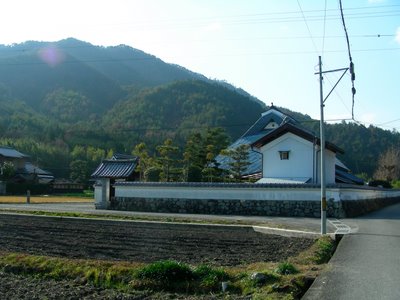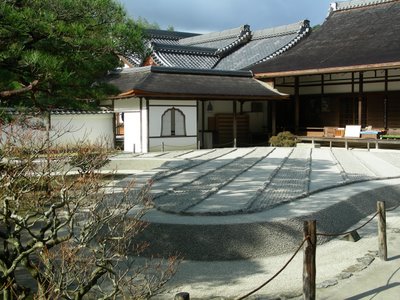
Here is the temple itself, though there were other buildings attached to the temple down the road, including a larger meditation hall and a guest house.
A scene from around the temple.
The next day we split into two groups and Bradley and I visited some famous Kyoto sites we'd never seen before: Kinkakuji and Ginkakuji (the gold and silver pavillions, respectively). Kinkakuji has been described by our friend Daisuke as the "interface between heaven and earth" and it truly was a rather breathtaking site, its mirror double floating over a lake filled with koi and small landscaped islands designed by the landscape master Muso Soseki.

Me and Bradley looking a bit awestruck. One of those amazing days when torrents of rain suddenly passed and the sun came out just as we were walking up the path to the temple.
Next we stopped by Ginkakuji, which was remarkable more for its sansui (raked sand( garden than for the pavillion itself. Although built in the 16th Century, the garden is eerily postmodern, and was supposedly built by the great landscape artist Soami. The garden represents Mt Fuji and the Pacific Ocean. Taiheiyo (the Ocean)
Taiheiyo (the Ocean)
We next walked the length of the so-called "Philosopher's Path," named after Nishida Kitaro (the founder of the Kyoto School of philosophy, and a longtime professor at Kyoto University). Since I have spent the last year studying Nishida and his disciples, it was particularly meaningful to, as it were, walk his walk.
Finally we headed up to Kiyomizudera and along the road saw a volley of brightly colored geishas (below).

The next day we set out for Mt Hiei, one of the most famous religious mountains in the world and the sight of the first major monasteries of Mahayana Buddhism in Japan. The temples of Mt Hiei were first built in the 9th Century.
 This is part of the original path that goes up (and down) Mt Hiei.
This is part of the original path that goes up (and down) Mt Hiei. Christo and Luna at a scenic overlook just below the temple complex of Enryaku-ji.
Christo and Luna at a scenic overlook just below the temple complex of Enryaku-ji. This is arguably the most (historically) important building on the grounds--a reconstructed version of the original ordination hall built by Saisho in the 8th Century. Tendai sect monks are still ordained here to this day.
This is arguably the most (historically) important building on the grounds--a reconstructed version of the original ordination hall built by Saisho in the 8th Century. Tendai sect monks are still ordained here to this day. Christo ringing one of the enormous bells on the mountain.
Christo ringing one of the enormous bells on the mountain. Here is a (borrowed) picture that gives a glimpse of the inside of the Konpon Chudo Hall. Inside the hall there is an oil lamp that has been continuously lit for 1200 years. The lamp was first lit by Saicho himself (or so legend says). Inside the Konpon-Chudo we wrote out a special ceremonial blessing for our (Christo and my) grandfather on a piece of wood which will be burned in the fires of the inner sanctum and hopefully help in the passage of his soul from this world to the next.
Here is a (borrowed) picture that gives a glimpse of the inside of the Konpon Chudo Hall. Inside the hall there is an oil lamp that has been continuously lit for 1200 years. The lamp was first lit by Saicho himself (or so legend says). Inside the Konpon-Chudo we wrote out a special ceremonial blessing for our (Christo and my) grandfather on a piece of wood which will be burned in the fires of the inner sanctum and hopefully help in the passage of his soul from this world to the next.

